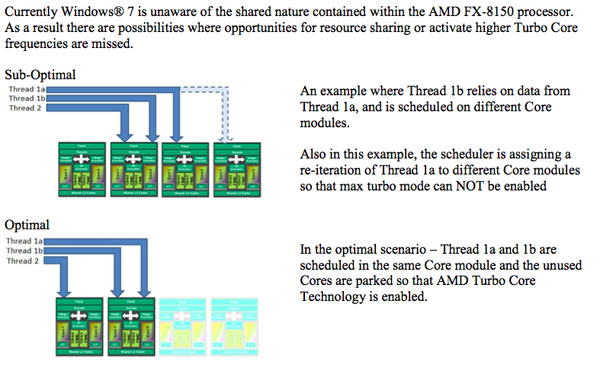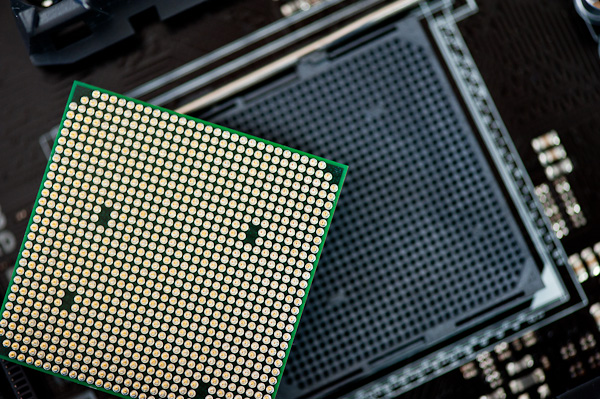The Bulldozer Review: AMD FX-8150 Tested
by Anand Lal Shimpi on October 12, 2011 1:27 AM ESTFinal Words
In many cases, AMD's FX-8150 is able to close the gap between the Phenom II X6 and Intel's Core i5 2500K. Given the right workload, Bulldozer is actually able to hang with Intel's fastest Sandy Bridge parts. We finally have a high-end AMD CPU with power gating as well as a very functional Turbo Core mode. Unfortunately the same complaints we've had about AMD's processors over the past few years still apply here today: in lightly threaded scenarios, Bulldozer simply does not perform. To make matters worse, in some heavily threaded applications the improvement over the previous generation Phenom II X6 simply isn't enough to justify an upgrade for existing AM3+ platform owners. AMD has released a part that is generally more competitive than its predecessor, but not consistently so. AMD also makes you choose between good single or good multithreaded performance, a tradeoff that we honestly shouldn't have to make in the era of power gating and turbo cores.
Bulldozer is an interesting architecture for sure, but I'm not sure it's quite ready for prime time. AMD clearly needed higher clocks to really make Bulldozer shine and for whatever reason it was unable to attain that. With Piledriver due out next year, boasting at least 10-15% performance gains at the core level it seems to me that AMD plans to aggressively address the shortcomings of this architecture. My only concern is whether or not a 15% improvement at the core level will be enough to close some of the gaps we've seen here today. Single threaded performance is my biggest concern, and compared to Sandy Bridge there's a good 40-50% advantage the i5 2500K enjoys over the FX-8150. My hope is that future derivatives of the FX processor (perhaps based on Piledriver) will boast much more aggressive Turbo Core frequencies, which would do wonders at eating into that advantage.

AMD also shared with us that Windows 7 isn't really all that optimized for Bulldozer. Given AMD's unique multi-core module architecture, the OS scheduler needs to know when to place threads on a single module (with shared caches) vs. on separate modules with dedicated caches. Windows 7's scheduler isn't aware of Bulldozer's architecture and as a result sort of places threads wherever it sees fit, regardless of optimal placement. Windows 8 is expected to correct this, however given the short lead time on Bulldozer reviews we weren't able to do much experimenting with Windows 8 performance on the platform. There's also the fact that Windows 8 isn't expected out until the end of next year, at which point we'll likely see an upgraded successor to Bulldozer.

So what do you do if you're buying today? If you have an existing high-end Phenom II system, particularly an X4 970 or above or an X6 of any sort, I honestly don't see much of a reason to upgrade. You're likely better off waiting for the next (and final) iteration of the AM3+ lineup if you want to stick with your current platform. If you're considering buying new, I feel like the 2500K is a better overall part. You get more predictable performance across the board regardless of application type or workload mix, and you do get features like Quick Sync. In many ways, where Bulldozer is a clear win is where AMD has always done well: heavily threaded applications. If you're predominantly running well threaded workloads, Bulldozer will typically give you performance somewhere around or above Intel's 2500K.
I was hoping for Bulldozer to address AMD's weakness rather than continue to just focus on its strengths. I suspect this architecture will do quite well in the server space, but for client computing we may have to wait a bit longer for a more competitive part from AMD. The true culprit for Bulldozer's lackluster single-threaded performance is difficult to track down. The easy answer would seem to be clock speed. We've heard of issues at Global Foundries and perhaps Bulldozer is the latest victim. If AMD's clock targets were 30% higher than Phenom II, it simply didn't make them with the FX-8150. I've heard future derivatives will focus more on increasing IPC indepedent of process technology and clock speed, but if you asked me what was the one limit to success I would say clock speed. As a secondary factor, AMD appeared to make some tradeoffs to maintain a reasonable die size at 32nm. Even then Bulldozer can hardly be considered svelte. I suspect as AMD is able to transition to smaller transistor geometries, it will be able to address some of Bulldozer's physical shortcomings.
The good news is AMD has a very aggressive roadmap ahead of itself; here's hoping it will be able to execute against it. We all need AMD to succeed. We've seen what happens without a strong AMD as a competitor. We get processors that are artificially limited and severe restrictions on overclocking, particularly at the value end of the segment. We're denied choice simply because there's no other alternative. I don't believe Bulldozer is a strong enough alternative to force Intel back into an ultra competitive mode, but we absolutely need it to be that. I have faith that AMD can pull it off, but there's still a lot of progress that needs to be made. AMD can't simply rely on its GPU architecture superiority to sell APUs; it needs to ramp on the x86 side as well—more specifically, AMD needs better single threaded performance. Bulldozer didn't deliver that, and I'm worried that Piledriver alone won't be enough. But if AMD can stick to a yearly cadence and execute well with each iteration, there's hope. It's no longer a question of whether AMD will return to the days of the Athlon 64, it simply must. Otherwise you can kiss choice goodbye.











430 Comments
View All Comments
Saxie81 - Wednesday, October 12, 2011 - link
Ouch.... Not looking good. :SThanks for the reply, again great review!!
velis - Wednesday, October 12, 2011 - link
Ignoring the power consumption it seems to me that @4.6GHz it should start being quite competitive.So can we expect base clocks to rise once significant volume of these chips starts getting out and GloFo refines the process?
I also must admit I didn't expect 2 bn transistors. All the time AMD was bragging about how much they saved and then we get this behemoth. No wonder they have process issues. Such big chips always do.
cfaalm - Wednesday, October 12, 2011 - link
Well it is an 8-core, not a 4 core. 2x 995M (Sandybridge 4C) almost 2B, though I am sure the multply isn't exactly correct. A lot of it depens on the L3/L2 RAM amounts. The savings seem to be minimal.I am still confused about why they so deliberately chose to go with a relatively low single thread performance. My main application is multithreaded, but since it's such a mixed bag overall I am pretty unsure if this will be my next CPU, unless I get to see convincing Cubase 6 benchies. For an FX moniker it needs to perform better than this anyway.
I'll throw in a lyric from The Fixx
"It doesn't mean much now, it's built for the future."
TekDemon - Wednesday, October 12, 2011 - link
Wow, no wonder they say you need water cooling or better to go 5Ghz+.enterco - Wednesday, October 12, 2011 - link
AMD should send a developer team to CryTek to help them release a patch able to use more cores :)medi01 - Wednesday, October 12, 2011 - link
Uhm, what about other numbers?IlllI - Wednesday, October 12, 2011 - link
this might be the final nail in the coffin. We might have to wait longer for it to be competitive? People have literally been waiting for -years- for amd to catch up.probably by the time piledriver(or whatever it'll be called) comes out, ib will be out (and even further behind intel)
btw I think tomshardware tested it with windows 8 and it was still a turd.
I seriously hope you can get some answers/reasons why amd released such a woeful product. Maybe this was why dirk was fired? All I know is after 7+ years of amd, my next processor will be intel
Ushio01 - Wednesday, October 12, 2011 - link
Desktop CPU's are Halo parts and as such are irrelevant. It's the Server and OEM Laptop CPU's were AMD needs to perform and AMD's server share just keeps dropping.lyeoh - Wednesday, October 12, 2011 - link
Thing is I wouldn't want to use them in my servers: http://us.generation-nt.com/answer/patch-x86-amd-c...FWIW when the Athlon64s first came out, we bought a bunch of them, they were not bad, but there were clock issues - the TSCs weren't synchronized. So had to set idle=poll (and thus using more watts).
You can blame the OS developers, but most people buy new hardware to run existing operating systems and programs on, not future unreleased ones.
It sure is looking bad for them. I won't be buying AMD CPUs but I hope the fanboys keep them alive ;).
OCedHrt - Wednesday, October 12, 2011 - link
"Other than the 8150, only the quad-core FX processors are able to exceed the 3.3GHz clock speed of the Phenom II X6 1100T."The 6 core FX is also clocked higher?